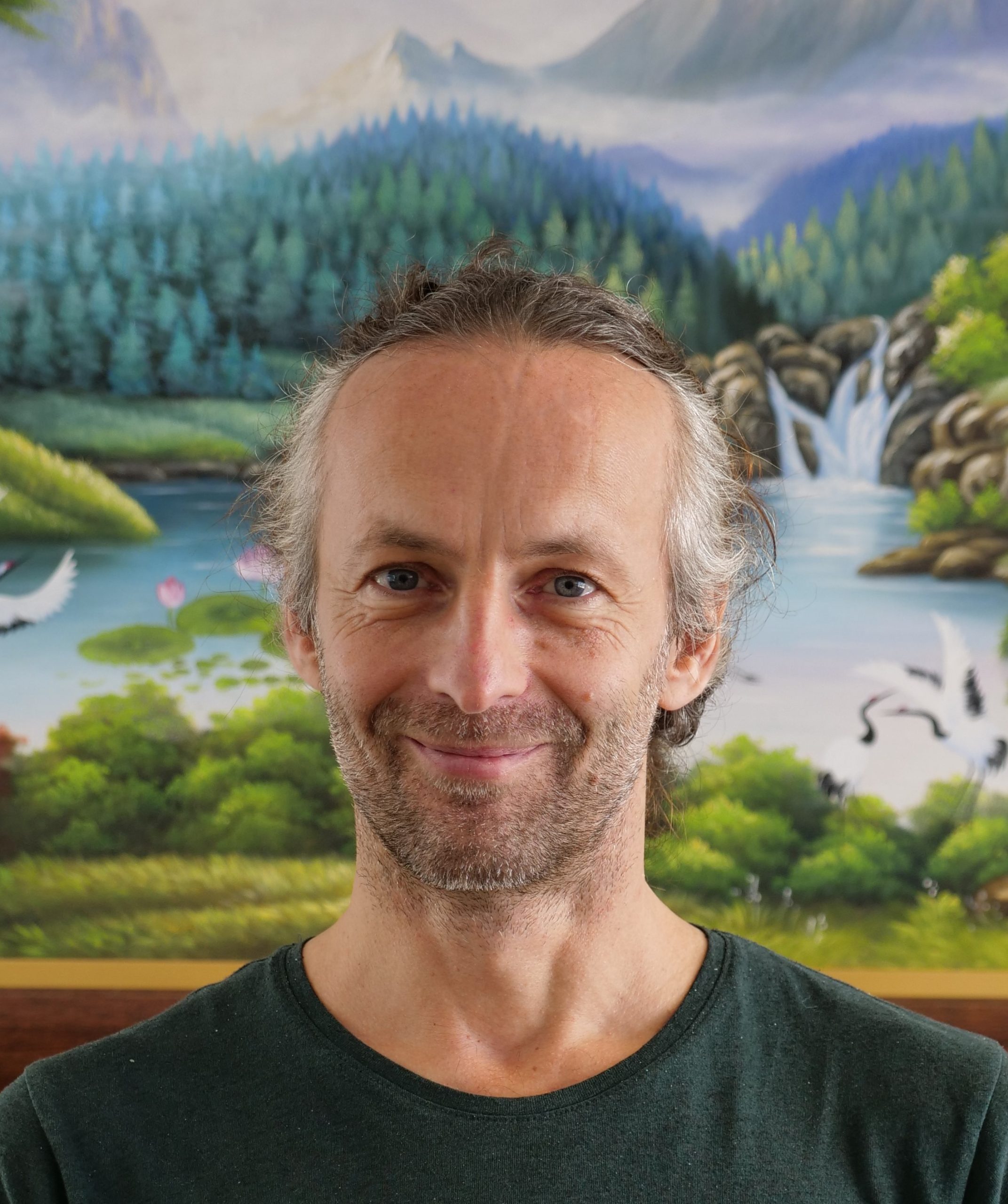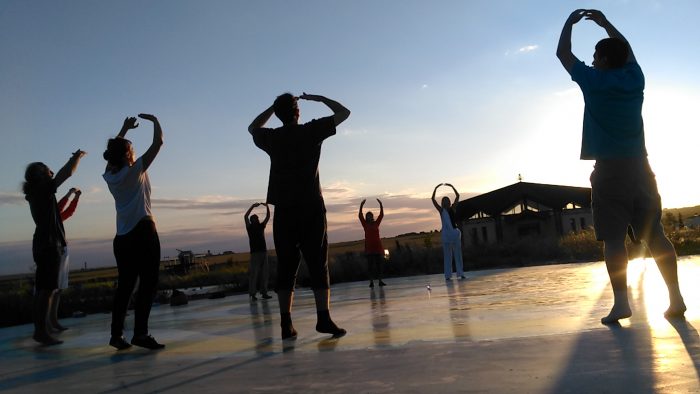Zoltan Cser spent his childhood in the lap of nature in Budapest, as his parents were speleologists (cave researchers). His uncle lived in Mongolia, so very early in his age, he was exposed to Buddhist culture.
As children, he and his sister found a Yesudian book about Hatha Yoga at home, and they started to practice by themselves. At 16, he started to practice Buddhism. He later became a monk and from 2003 he started to practice in the International Dzogchen Community.
Zoltan tells Indica Yoga that later he managed to practice many different systems and he went looking for them as he wanted to try them, investigate them, because he sees “the tremendous importance of Yoga in learning to live a valuable life. So free will (rather than anything external) led me to Yoga.”

Your parents were cave researchers and you probably got a lot of time to be with nature as a child. What can we learn from nature that we can't otherwise?
If we would like to answer in a very simple way, in Buddhism enlightenment is called the nature of mind (dharmat?), so to be natural is the key to attain the goal. How to be natural? We can learn from nature. Human mental fabrications are artificial, like we can compare a forest with a city, one is natural, and one is artificial.
You turned to Buddhism early in your life. What does Buddhist Dharma tell one about Yoga and its practice?
Yoga has different meanings in Buddhism according to the different currents. In southern Buddhism (Therav?da) we find the term Yoga as being controlled, yoked by negative tendencies, there are four Yogas: sensual desire, attachment to existence, wrong views and fundamental ignorance. In northern traditions (Mah?y?na) Yoga means to yoke, to control the mind, doing Yoga means to cultivate meditation.
In tantric teachings Yoga means union, union with our primordial nature, with the state of the Buddha. In Tibetan traditions the term Yoga is translated as possessing the natural state (rnal sbyor). In every tradition of Buddhism we find body movement practices, sometimes called stretching exercises, sometimes the actions of the Buddhas, sometimes just exercises or massaging the energy body, but the most common term for physical movement practices is Yantra. So doing yantra means someone is practicing ?sanas and pr?n?y?mas in order to attain the state of meditation.
Why did you choose to become a monk? Is Vairagya an important condition for Yoga and Meditation?
When I was 20 years old, the only thing obvious to me was that the only way for spiritual development is renunciation. Being a monk, then entering retreat, I thought this is the way to totally cut the connection with samsara and attain vairagya. But in retreat there are the retreat problems, being a monk you face monk problems, so the question is: what is the source of all our problems?
After one year in retreat and 9 years of intense practice my life changed. I was asked to teach at the Buddhist College, so I had to open up again to the world. That is another kind of renunciation, being a lay person and trying to integrate practice with daily life. In Buddhism basically there are two causes that lead to bondage of samsara. One is the three kind of desires (k?ma, bhava, vibhava), the other ignorance (avidy?) which is the root of every limitation, suffering. To eliminate desire one of the methods is being a monk. But to eliminate ignorance we need more capacity and lots of experience.
Who was your guru and what is his lineage? How does this lineage impact your life?
My first teacher was the abbot of a Chan lineage who came to Hungary in the eighties, where the practices were based on martial arts, medicine connected with Chi kung and energy Yogas (Tao yin gymnastic) methods and astrology. Here the philosophy was based on one hand on the Tien Tai teachings, meditation on the other hand on Chan (Zen). This tradition gave me the clear conviction that a spiritual path very much depends on practicing with the body and breathing.
Then 20 years ago I met Choegyal Namkhai Norbu Rinpoche from the Tibetan Nyigma tradition who openly taught Yantra Yoga, one the most ancient movement practices among the Yoga systems (coming from Humk?ra mah?siddha VIII. century, Nepal) and Vajradance which is an even more secret practice in Tibetan Buddhism. Rinpoche taught an incredible system of 9 levels of theory and meditation education system, called Sant Maha Sangha (Dzogchen Community, SMS). So I practice mostly Yantra Yoga and Vajradance and SMS and years later I managed to become an instructor of all three. I was very fortunate that I could, mostly at the College, translate many many Therav?da, Zen and Tibetan Masters, translate teachings and also practice retreats. This way I could learn a lot first hand about Buddhism. Also I translated for five years in Hungary Dr Indu Arora’s works, who taught ?yurveda, Yoga Teacher Trainings, Yoga therapy which also a great impact on my practice and understanding.
How is your practice different from Hatha Yoga?
Yantra means machine or mystical diagram, but here it refers to movement, movement of the body, movement of the breathing, movement of the pr?na. Yoga means natural state, so Yantra Yoga means to attain natural state by way of movement. This practice is like a rosary consist of 108 practices in a sequence that start from purification practices, eliminating obstacles from the joints, purifying pr?na, controlling the channels, then 75 yantra rendered into 5 groups. In every group there are five basic yantra, five for training and five for progressing, so together 5x5x3 (75). All the five group connected to one specific Pr?n?y?ma. At the end there are 7 practices connected to lotus position and Vajra wave to eliminate any obstacles. In all the yantras we find one asana most of them known also in Hatha Yoga, but here in every asana we hold the breath in a specific way.
In all the yantras we count the rhythm. There is an initial part inhale, exhale for four count together with movement of the body, then in the central part we go to the asana, holding the breath and with movement we release it, at the and there is a concluding phase inhalation and exhalation for four count together with movement. So all the base yantras takes 28 beats, around half a minute. When we are at a more advanced level we can hold the breathing in the asana according to our capacity. So movement together with the proper breathing is a very important part of that system and in the asana the precise holding the breath. This Yantra system is brilliantly logical, by that we can understand, how from moving the body we can train the breathing and this way balancing the elements, pr?nas and attain the natural state of mind. To relax the mind we should relax the energy, to relax the energy we should relax the body.
According to Rinpoche: “In Yantra Yoga there are many poses that are similar to those in Hatha Yoga. There is a difference, however, in the way they are performed. In Yantra Yoga the pose is not the main thing; instead what is essential is the sequence of movements, interconnected with the breathing, performed to assume the pose. Both the movements and the pose are done for a limited time, based on a fundamental cycle of four counts.” (from the book: Chögyal Namkhai Norbu, 2008. Yantra Yoga, the Tibetan Yoga of movement, Snow Lion Publication, Ithaca, New York, p.12.)
You teach Vajra dance which is performed on mandalas. What is the connection between Tibetan Yoga practice, mandalas and dance?
In the so called Highest Tantras (anuttara tantra) we find always a Yantra system to control the pr?nas, stabilise them in the Central Channel. When the pr?nas are moving in the Central Channel that is called Vajradance. This is the dance of bliss. Usually there are Mask dances when the dancers are representing the Deities, the Buddhas of the mandala, and they are performing virtuous deeds during the dance, this is the outer aspect of mandala. There are Vajradances connected to the energy level, when the dancers are dancing on the mandala representing the chakras, this is the inner aspect of mandala (Tibetan Yoga is mostly are connected to this level) and there are Vajradances that connected to our enlightened state (non-dual mandala).
The Vajradance that Rinpoche taught is connected to Dzogchen, so to our nature of mind. One time Rinpoche mentioned that Yantra Yoga is inner dance, dance of energy and Vajradance is the dance of Wisdom. Sometimes the tantric practices are divided into three categories: outer mandala practice (visualization, s?dhan?, mantra recitation), inner mandala practices (movement of the body, breathing practices, inner heat) and non-dual of the two mandalas (Mah?mudr?) and the three levels of above mentioned sacred dances are connected to these levels.
What is the Kumar Kumari tradition?
Kumar Kumari Yantra comes from Namkhai Norbu Rinpoche. This is a special movement system especially for children. Here the movements are similar to Yantra Yoga (instead of 108 practices here we find altogether 16 practices) but the way to perform them is different. In Kumar Kumari all the movements are performed with uttering sounds, sacred mantric syllables. There is no holding of the breath but like in a dance, every movement is connected to a sound that we utter through the nose and mouth together. To every part of the practice we can find the particular indication how this movement contributes to the harmonious growing up of the children.
What has your academic life involved? How does teaching and practicing in a monastery increase the intensity as compared to the outside world?
As far as I am concerned now I am teacher at Dharma Gate Buddhist College, where I spent eight years as Vice Rector. During that time mostly I was responsible of educational questions, developing new curriculum, organising semesters and so on. I was involved in interreligious round table meetings, conferences, so also articles were published in this theme. The past few years I have studied in Doctoral schools, one in Budapest (Mongolian studies), one in Thailand (International Buddhist Studies), in both cases I just have to write my Thesis and defend it for getting the degree. I have participated in several Buddhist conference in Norway, Estonia, Sri Lanka and scientific conferences in Hungary, and Mongolia. My main research field is movement, breathing and meditation practices in Buddhism. Nowadays more and more scholars in the scientific fields are practitioners as well, although the way we approach spiritual teachings is different as a student of a Guru or as a student of a Professor, but in Buddhism the aim is to discover what reality the same way as in Science is. The method how we do is different: in Buddhism it more subjective: by reasoning and direct experience; meditation, in science it is more objective: by reasoning and experiments.
The inside of the Buddhist temple is filled with violent images of different creatures but the teachings are of calming compassion? Is this because of the influence of the earliest Tibetan religions?
In Buddhism there are different ways to use images. In southern Buddhism all objects of veneration has the role to remind us to the Buddha (statue, tree, stupa etc.), in Mah?y?na Buddhism the depictions are different representatives of enlightenment, Buddhas and Bodhisattvas where we use this images in Puja practices visualizing them. In Vajrayana the Deities are representing main aspects of enlightened energies. In Vajrayana or Tantra the method is to transform the poisoned, negative states of mind, the negative energies. There are three main poisons: ignorance, hatred and desire. To transform ignorance we use peaceful figures as a base of visualization, to transform hatred we use wrathful forms and to transform desire we use figures in sexual union as base of visualization. Wrathful forms are also represent compassion but more active way, they are helping to destroy the negative states. All the parts of the deity symbolises an aspect of the practice, an aspect of enlightened state of mind.
Is Yoga and Meditation in the Tibetan tradition common in Budapest?
In Budapest there are 37 Buddhist practice groups, many of them is connected to Tibetan Buddhism. Although not many are practicing Tibetan Yogas because they are usually secret practices. In Dzogchen Community, in Yundrug Bon community, in a Nyigma-Kagyu community there are Yogas. We practice Yantra Yoga, in Bon community Zhang Zhung Nyengyu Yoga, and Pema Lingpa Yoga in the third community.
Have you met Indian traditional gurus? How would you describe their teaching as compared to your guru?
Yes, I managed to learn from Indian Gurus, for me the most important was Indu, and learning a lot from Her. We could share our experiences, our understanding of Yoga from different perspectives, it was really a wonderful collaboration. I respect Her very much. For example Rinpoche’s teaching was based very much on working with circumstances, to see the situation that is different in the West. Indu taught in a way where we could understand the depth and sacredness of Yoga, very much emphasizing the spiritual aims of this system, Yoga as a whole life. They taught in a way which could inspire us, finding the right words and methods suitable to us, and also giving the possibility to develop, to find our way. Both of them gave importance to freedom but with responsibility.





